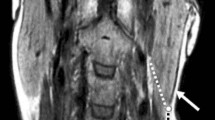Abstract
Objective
To analyze the effectiveness of the multiplanar analysis of the retromandibular vein in establishing the position of the parotid gland tumor and its relationship with the facial nerve, together with the most common radiological criteria (facial nerve line, Utrecht line, retromandibular vein and parapharyngeal space variations) using the magnetic resonance imaging.
Study design
Retrospective study
Setting
Tertiary Academic Hospital
Subjects and methods
128 preoperative magnetic resonances were analyzed to study preoperative tumor location (medial or lateral to the expected course of the facial nerve) based on comparison between the radiological criteria and the surgical findings.
Results
FN line had the lowest accuracy at 77%, whereas the retromandibular vein achieved 85% accuracy and the UT line achieved accuracy of 93%. The retromandibular vein could not be identified in 11 cases (9%). The multiplanar evaluation of the retromandibular vein allowed us to identify it on almost all MR images (99% of cases) and reach 87% of accuracy. The parapharyngeal space evaluation achieved 92% of accuracy. In the subgroup of 66 cases where the neoplasms were strictly related to the main trunk, where the surgery entailed manipulation if situated laterally to the tumor, the multiplanar evaluation of the retromandibular vein reached 98% of accuracy and UT line achieved 94%.
Conclusions
The multiplanar modality, combined with the evaluation of the parapharyngeal space, is effective in helping the surgeon to achieve accurate planning: it enables the tumor to be located and the facial nerve course predicted with a good precision.



Similar content being viewed by others
References
Ettl T, Schwarz-Furlan S, Gosau M, Reichert TE (2012) Salivary gland carcinomas. Oral Maxillofac Surg 16(3):267–283. https://doi.org/10.1007/s10006-012-0350-9
Grazioli L, Olivetti L, Matricardi L et al (1989) Comparison of ultrasonography, computerized tomography, and magnetic resonance in the study of parotid masses. Radiol Med 86(3):268–280. https://doi.org/10.1017/CBO9781107415324.004
Vanderheiden SM (2015) Malignant parotid tumor imaging. http://Emedicine.Medscape.Com/article/384211 (Epub)
Lee SC (2015) Salivary Gland neoplasms workup. http://Emedicine.Medscape.Com/article/852373 (Epub)
Ishibashi M, Fujii S, Kawamoto K et al (2010) The ability to identify the intraparotid facial nerve for locating parotid gland lesions in comparison to other indirect landmark methods: evaluation by 3.0 T MR imaging with surface coils. Neuroradiology 52(11):1037–1045. https://doi.org/10.1007/s00234-010-0718-1
Lim CY, Chang HS, Nam KH, Chung WY, Park CS (2008) Preoperative prediction of the location of parotid gland tumors using anatomical landmarks. World J Surg 32(10):2200–2203. https://doi.org/10.1007/s00268-008-9663-0
Ariyoshi Y, Shimahara M (1998) Determining whether a parotid tumor is in the superficial or deep lobe using magnetic resonance imaging. Oral Maxillofac Surg 56(1):23–26
Vaiman M, Luckman J, Sigal T, Bekerman I (2016) Correlation between preoperative predictions and surgical findings in the parotid surgery for tumors. Head Face Med 12(1):4. https://doi.org/10.1186/s13005-016-0100-6
de Ru JA, van Benthem PP, Hordijk GJ (2002) The location of parotid gland tumors in relation to the facial nerve on magnetic resonance images and computed tomography scans. J Oral Maxillofac Surg 60(9):992–994
Imaizumi A, Kuribayashi A, Okochi K et al (2009) Differentiation between superficial and deep lobe parotid tumors by magnetic resonance imaging: usefulness of the parotid duct criterion. Acta radiol 50(7):806–811. https://doi.org/10.1080/02841850903049358
Divi V, Fatt MA, Teknos TN, Mukherji SK (2005) Use of cross-sectional imaging in predicting surgical location of parotid neoplasms. J Comput Assist Tomogr 29(3):315–319. https://doi.org/10.1097/01.rct.0000161758.25130.34
Liu Y, Zhong L-P (2016) Reply to “Accuracy of diagnosis of salivary gland tumors with the use of ultrasonography, computed tomography, and magnetic resonance imaging: a meta-analysis-a commentary”. Oral Surg Oral Med Oral Pathol Oral Radiol 121(3):341–343. https://doi.org/10.1016/j.oooo.2015.11.013
Piagkou M, Tzika M, Paraskevas G, Natsis K (2013) Anatomic variability in the relation between the retromandibular vein and the facial nerve: a case report, literature review and classification. Folia Morphol 72(4):3711–3715
Kurabayashi T, Ida M, Ohbayabhi N (1993) Criteria for differentiating superficial from deep lobe tumours of the parotid gland by computed tomography. Dermatomaxillofac Radiol 22:81–85
Poletti AM, Dubey SP, Colombo G, Cugini G (2016) Surgical management of parapharyngeal space tumors: the role of cervical and lateral skull base approaches. Ear Nose Throat J Dec 95(12):E1–E16
Aknowledgements
We thank Dr. Emanuela Morenghi, Biostatistic Dept. Humanitas Clinical and Research Center, Rozzano Milano, Italy
Author information
Authors and Affiliations
Corresponding author
Ethics declarations
Ethical approval
We did not receive any funding and had not any sponsor in this study and it was reviewed in accordance with the principles of medical ethics and has been approved by the Ethics Independent Committee of Humanitas Clinical and Research Hospital at number 18/17.
Rights and permissions
About this article
Cite this article
Poletti, A.M., Imparato, S., Signorelli, G.C. et al. The multiplanar analysis of the retromandibular vein in surgical planning for parotid gland tumors. Eur Arch Otorhinolaryngol 275, 1587–1593 (2018). https://doi.org/10.1007/s00405-018-4953-0
Received:
Accepted:
Published:
Issue Date:
DOI: https://doi.org/10.1007/s00405-018-4953-0




